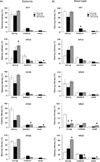The rate of wound healing is increased in psoriasis
- PMID: 23819987
- PMCID: PMC4445836
- DOI: 10.1016/j.jdermsci.2013.06.001
The rate of wound healing is increased in psoriasis
Abstract
Background: Psoriasis shares many features with wound healing, a process that involves switching keratinocytes from growth to differentiation. Ca2+ is known to regulate this process. The N-methyl-d-aspartate receptor (NMDAR), an ionotropic glutamate receptor found on keratinocytes, is expressed abnormally in psoriasis in vivo.
Objectives: The goals of this study are to determine whether the rate of healing in the skin of psoriatic individuals differs from that observed in normal skin and whether the keratinocyte hyperproliferation found in psoriasis correlates with expression of specific NMDAR subunits.
Methods: Three mm punch biopsies were performed on the skin of normal, as well as, involved and uninvolved skin of subjects with psoriasis. On day 0, as well as, on day 6 after the biopsy, photographs were taken and the size of the wounds determined using ImageJ. Using immunohistochemistry, the biopsy material was stained for NMDAR and its subunits.
Results: Involved and uninvolved skin of individuals with psoriasis shows significantly more rapid healing than normal. The NR2C subunit of NMDAR is down-regulated in the basal cell layer of involved and uninvolved epidermis of psoriatic subjects compared to controls. By contrast, cells in the basal cell layer of the uninvolved epidermis showed a significantly greater percent strong staining for NR2D compared to those cells in normal epidermis.
Conclusions: Wound healing is significantly accelerated in psoriasis compared to normal. Immunohistochemistry showed that the relative intensity of strong immunostaining for subunits of the NMDAR is altered in the basal cell layer in psoriatic skin compared to normal controls. We suggest that these alterations may contribute to the increased rate of wound healing in psoriasis.
Keywords: Keratinocyte proliferation; NMDA-receptor; Psoriasis; Wound healing.
Copyright © 2013 Japanese Society for Investigative Dermatology. Published by Elsevier Ireland Ltd. All rights reserved.
Conflict of interest statement
Figures



Similar articles
-
Psoriatic keratinocytes are resistant to tumor necrosis factor alpha's induction of mRNA for the NMDA-R2C subunit.Exp Dermatol. 2013 Nov;22(11):750-1. doi: 10.1111/exd.12242. Exp Dermatol. 2013. PMID: 24102971
-
The expression of syndecan-1 in psoriatic epidermis.Arch Dermatol Res. 2008 Aug;300(7):393-5. doi: 10.1007/s00403-008-0848-z. Epub 2008 Apr 2. Arch Dermatol Res. 2008. PMID: 18386024 Free PMC article.
-
Podoplanin expression in wound and hyperproliferative psoriatic epidermis: regulation by TGF-β and STAT-3 activating cytokines, IFN-γ, IL-6, and IL-22.J Dermatol Sci. 2012 Feb;65(2):134-40. doi: 10.1016/j.jdermsci.2011.11.011. Epub 2011 Dec 8. J Dermatol Sci. 2012. PMID: 22189341
-
MiRNA expression in psoriatic skin: reciprocal regulation of hsa-miR-99a and IGF-1R.PLoS One. 2011;6(6):e20916. doi: 10.1371/journal.pone.0020916. Epub 2011 Jun 7. PLoS One. 2011. PMID: 21687694 Free PMC article.
-
Reciprocal altered expression of T-cadherin and P-cadherin in psoriasis vulgaris.Br J Dermatol. 2003 Aug;149(2):268-73. doi: 10.1046/j.1365-2133.2003.05464.x. Br J Dermatol. 2003. PMID: 12932231
Cited by
-
Koebner phenomenon leading to the formation of new psoriatic lesions: evidences and mechanisms.Biosci Rep. 2019 Dec 20;39(12):BSR20193266. doi: 10.1042/BSR20193266. Biosci Rep. 2019. PMID: 31710084 Free PMC article. Review.
-
Identification of regenerative roadblocks via repeat deployment of limb regeneration in axolotls.NPJ Regen Med. 2017 Nov 6;2:30. doi: 10.1038/s41536-017-0034-z. eCollection 2017. NPJ Regen Med. 2017. PMID: 29302364 Free PMC article.
-
Non-Coding RNAs: New Players in Skin Wound Healing.Adv Wound Care (New Rochelle). 2017 Mar 1;6(3):93-107. doi: 10.1089/wound.2016.0711. Adv Wound Care (New Rochelle). 2017. PMID: 28289554 Free PMC article. Review.
-
Biomechanical Factors in Psoriatic Disease: Defective Repair Exertion as a Potential Cause. Hypothesis Presentation and Literature Review.ACR Open Rheumatol. 2019 Aug 8;1(7):452-461. doi: 10.1002/acr2.11056. eCollection 2019 Sep. ACR Open Rheumatol. 2019. PMID: 31777825 Free PMC article. Review.
-
Genome-wide transcriptome analysis identifies alternative splicing regulatory network and key splicing factors in mouse and human psoriasis.Sci Rep. 2018 Mar 7;8(1):4124. doi: 10.1038/s41598-018-22284-y. Sci Rep. 2018. PMID: 29515135 Free PMC article.
References
-
- Ormerod AD, Weller R, Copeland P, Benjamin N, Ralston SH, Grabowski P, et al. Detection of nitric oxide and nitric oxide synthases in psoriasis. Arch Dermatol Res. 1998;290:3–8. - PubMed
-
- Morhenn VB. Is psoriasis a disease of the immune system? Cutis. 1984;34:223–224. - PubMed
-
- Uyemura K, Yamamura M, Fivenson DF, et al. The cytokine network in lesional and lesion-free psoriatic skin is characterized by a T-helper type 1 cell-mediated response. J Invest Dermatol. 1993;101:701–705. - PubMed
-
- Griffiths CE, Barker JN. Pathogenesis and clinical features of psoriasis. Lancet. 2007;370:263–271. - PubMed
Publication types
MeSH terms
Substances
Grants and funding
LinkOut - more resources
Full Text Sources
Other Literature Sources
Medical
Miscellaneous

